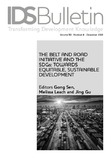The Belt and Road Initiative and Africa’s Sustainable Development: A Case Study of Kenya
| dc.contributor.author | Gu, Jing | |
| dc.contributor.author | Qiu, Shen | |
| dc.date.accessioned | 2019-12-17T11:58:02Z | |
| dc.date.available | 2019-12-17T11:58:02Z | |
| dc.date.issued | 2019-12-17 | |
| dc.identifier.citation | Gu, J. and Qiu, S. (2019) The Belt and Road Initiative and Africa’s Sustainable Development: A Case Study of Kenya in Sen, G., Leach, M. and Gu, J. (Eds) The Belt and Road Initiative and the SDGs: Towards Equitable, Sustainable Development, IDS Bulletin 50.4, Brighton: IDS | en |
| dc.identifier.uri | https://opendocs.ids.ac.uk/opendocs/handle/20.500.12413/14892 | |
| dc.description.abstract | There is extensive international debate over the contribution of the Belt and Road Initiative (BRI) to achieving the global Sustainable Development Goals (SDGs). The potential for the BRI to make a substantial contribution to realising the SDGs has been acknowledged by leading global, regional, and national representatives. The BRI as a developmental project with global reach is heavily backed financially by China, and reflects the need for stronger instruments to implement and deliver on the 2030 Agenda for Sustainable Development and the SDGs. Yet, there are practical challenges in the BRI–SDG relationship set against an international debate centred on concerns, criticisms, and ‘pushback’. This article assesses this relationship and provides a comprehensive examination of China–Kenya cooperation under the BRI and its implications for Kenyan implementation of the SDGs. Its arguments are based on both official documents and data, and primary research. Its findings contribute to the discussion on the potential of the BRI for Africa’s sustainable development. | en |
| dc.description.sponsorship | Center for International Knowledge on Development’s (CIKD) China–UK Partnership Programme on Knowledge for Development. | en |
| dc.language.iso | en | en |
| dc.publisher | Institute of Development Studies | en |
| dc.relation.ispartofseries | IDS Bulletin;50.4 | |
| dc.rights | This is an Open Access article distributed under the terms of the Creative Commons Attribution Non Commercial 4.0 International licence (CC BY-NC), which permits use, distribution and reproduction in any medium, provided the original authors and source are credited, any modifications or adaptations are indicated, and the work is not used for commercial purposes. http://creativecommons.org/licenses/by-nc/4.0/legalcode | en |
| dc.rights.uri | http://creativecommons.org/licenses/by-nc/4.0/ | en |
| dc.subject | Development Policy | en |
| dc.title | The Belt and Road Initiative and Africa’s Sustainable Development: A Case Study of Kenya | en |
| dc.type | Article | en |
| dc.rights.holder | Institute of Development Studies | en |
| dc.identifier.team | Business, Markets and the State | en |
| dc.identifier.doi | 10.19088/1968-2019.140 | |
| dcterms.dateAccepted | 2019-12-17 | |
| rioxxterms.funder | Default funder | en |
| rioxxterms.identifier.project | Default project | en |
| rioxxterms.version | VoR | en |
| rioxxterms.funder.project | 9ce4e4dc-26e9-4d78-96e9-15e4dcac0642 | en |
Files in this item
This item appears in the following Collection(s)
Except where otherwise noted, this item's license is described as This is an Open Access article distributed under the terms of the Creative Commons Attribution Non Commercial 4.0 International licence (CC BY-NC), which permits use, distribution and reproduction in any medium, provided the original authors and source are credited, any modifications or adaptations are indicated, and the work is not used for commercial purposes. http://creativecommons.org/licenses/by-nc/4.0/legalcode


